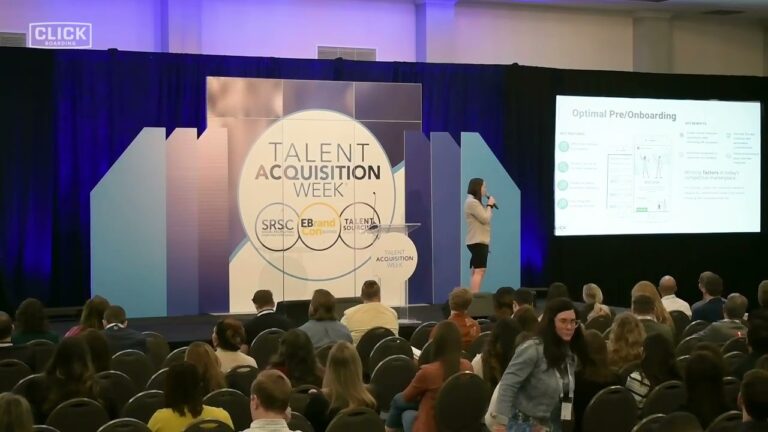New Hire Onboarding Best Practices
Let’s examine what a consumer-savvy, enterprise-grade onboarding experience looks like by exploring nine proven onboarding best practices for keeping what matters most top of mind. We’ll start by making the distinction between traditional onboarding and modern onboarding:
Traditional onboarding
The practice of providing the necessary paperwork to set an employee up for payroll, benefits and IT. Frequently, it includes orientation and learning materials delivered manually on Day One. It’s typically paper driven, and onboarding success is measured by compliance only.
Modern onboarding
The practice of welcoming a new hire into the organization via a self-guided, mobile-first journey that reinforces their confidence in joining the team, prepares them to connect with the culture and helps them quickly become productive. It starts the moment an offer is accepted and continues as critical moments in the employment journey unfold like lateral moves, internal reorgs, offboarding and M&A. It’s always mobile first, and success is measured on retention, engagement, productivity and compliance.
SHRM.org recognized Click Boarding for our employee onboarding app which can function as a stand-alone product or as an integration with a variety applicant tracking, payroll, HR information and learning management systems.
Some hard truths to think about:
- It should not feel more thrilling to buy a pair of shoes online than making a career change.
- We should not feel more relaxed booking an AirBnB on a remote island than we do about meeting our team on the first day of work.
- We should not accept that Amazon can predict what we need better than our new manager.
Why are consumer experiences so tough to compete with? Because the best consumer brands are relentlessly focused on the only thing that matters: how we feel. They’re obsessed with making us consistently feel something unique while delighting us at every turn.
Here are a few ways that play out in the modern consumer experience:
When we impulse-buy those epic shoes on Revolve, it’s flawless. We’re whisked to our cart where our data auto-populates and nothing slows down our journey to the “Buy Now” button. We’re instantly gratified with a confirmation email. Finally, we’re urged to celebrate our lack of self-control on social networks.
We feel excitement and confidence.
When we book that AirBnB on a remote island, it is oddly un-scary. We are greeted with a virtual tour that shows us what we are getting into. We’re transparently educated by guests who can tell us what to really expect. Finally, we’re instantly connected to our host who guides us with tips only a local would know.
We feel trust and inclusivity.
When we sign up for Amazon Prime and start sticking Dash buttons all over the house, it’s surprisingly satisfying. Run out of Tide? Boom, it’s on the doorstep. Can’t get to the grocery store? Boom, groceries are on the doorstep. We feel simplicity.
Consumer expectations = employee expectations
As consumers, our expectations are shooting through the roof at an astonishing rate as we experience a subconscious shift in patience. As each friction point between what we want and how we get it disappears, we forget how hard it was before smartphones. Super quick reminder: it was hard, and everything took f o r e v e r.
Now is the time for HR teams to drive the same kind of brand loyalty that consumer brands do, and it’s not as far-fetched as it sounds. Employees spend more time with your employment brand than anything else. It should be the one brand they feel the most excited about.
Onboarding Best Practices
1. A mobile first, self-guided experience before Day One
Modern onboarding starts the moment a decision to join is made. For the new hire, it starts on the day of offer acceptance. For employees who need to “reboard” in a new role, it starts when they accept the challenge!
Similar to making a purchase at your favorite online retailer, a mobile first, self-guided experience means that cascading steps can be completed on a mobile device and as they are, progress is visually tracked and instructions are intuitively delivered.
This best practice provides a clear picture of what to expect next and makes the employee feel prepared.
2. An authentic welcome from the boss before Day One
Modern onboarding amplifies authenticity. Rather than a cold, canned message from the corporate office that accompanies an offer letter (that may or may not be accepted), a personal welcome message or video from the CEO or manager is delivered quickly after the offer is accepted.
Like a consumer brand thanking you for your purchase, sending a text, email or video feels more personal, relevant and above all, authentic.
This best practice reinforces the employee’s decision to join your organization to make them feel genuinely valued and appreciated.
3. A zero-redundancy form experience
Modern onboarding respects everyone’s time. Instead of spending the first day on the job with a pile of mind-numbing forms like background checks and I-9s, eSignature is set up before Day One. All applicable forms are fed to the new hire in the order they need to be received for compliance
Much like a consumer account, forms progressively auto populate with saved data, making each successive step easier for the new hire to complete.
This best practice shows respect for everyone’s time and makes the employee feel confident. Plus, it’s what they expect.
4. An enthusiastic welcome from the team before Day One
Modern onboarding understands the value of teams and the subtle importance of socialization. Instead of meeting team members one by one when they are busy and distracted, just make a video online to give new hires an enthusiastic welcome from the team before Day One.
Like consumer brands that use social media videos to bring consumers closer to products being used in real life, team videos can show new hires a day in the life or give new hires a virtual tour of the office. The possibilities here are endless.
This best practice alleviates awkward moments on Day One, brings culture to life, introduces some friendly faces and shows the new hire that the new team is excited to meet them.
5. A chance to have a GREAT first day
Modern onboarding is obsessed with first impressions. Instead of wasting the first day at work locked in a conference room filling out benefits forms and learning about PTO policies, the first day can be spent diving in and feeling like a part of the team.
Answering the often unasked – but anxiety-producing – questions of where to go and when, what to wear and what to expect along with full information on benefits, PTO, perks and policies help the new hire know what to expect. It’s an FAQ we’d all like when we start a new adventure!
This best practice answers “all of the things,” makes a new hire feel informed and empowered, relieves the inevitable Day One anxiety and gives them a chance to make a great first impression with their new team.
6. A toolbox from Day One
Modern onboarding wastes no time. Instead of hearing “next week when you have your laptop and access…,” new employees have every tool they need to be productive from Day One.
- Direct deposit? Already submitted.
- Business cards? Top right desk drawer.
- Laptop, software and logins – done, done and done.
Creating a consistent and automated process to coordinate and align all of the various internal players who are essential in getting a new employee work-ready makes the employee feel welcome. It also reduces strain and stress on said internal departments.
This best practice accelerates productivity and makes new employees feel like their arrival is greatly anticipated.
7. A welcome party
At the risk of sounding redundant, modern onboarding is obsessed with first impressions. Instead of randomly meeting the team one by one while they’re distracted with other tasks, the entire team can take 10 minutes to assemble, focus on saying hello and show the new hire a cohesive group that collectively works together. If possible, we recommend a mentor to help them make the rounds, get to know the team and navigate the building.
Much like consumer brands who encourage brand communities, this best practice:
- minimizes first-day jitters
- prevents feelings of awkward isolation
- makes new hires feel connected to their peers
8. An agenda
Modern onboarding is organized, efficient and productive – immediately. Instead of squandering the first month with an unstructured schedule, new hires are scheduled to attend team meetings and assimilate into project teams in real time.
This best practice creates opportunities to learn the ropes faster and become productive sooner, making new hires feel valuable to the team.
9. A genuine fist bump from the boss (or elbow pump, post-COVID)
Modern onboarding understands the power of frequent feedback and encouragement. Instead of waiting until a 30-day review to reconnect the boss and new hire, managers send a text at the end of Day One to congratulate the new hire on a great first day.
This best practice opens the door to meaningful conversations, reinforces the employee’s decision and builds trust which makes the new hire feel confident.
That’s it: our nine onboarding best practices that tie modern onboarding to what matters most for new hires. Use these tried-and-true methods to deliver a mobile-first, intuitive onboarding experience that eliminates boring paperwork, engages employees before and after Day One, drives a 50% increase in retention and simplifies the HR process.
Get the rest of the modern onboarding story! Download our free Demystifying Modern Onboarding eBook. This step-by-step playbook gives you the inside track on delivering amazing employee experiences.



